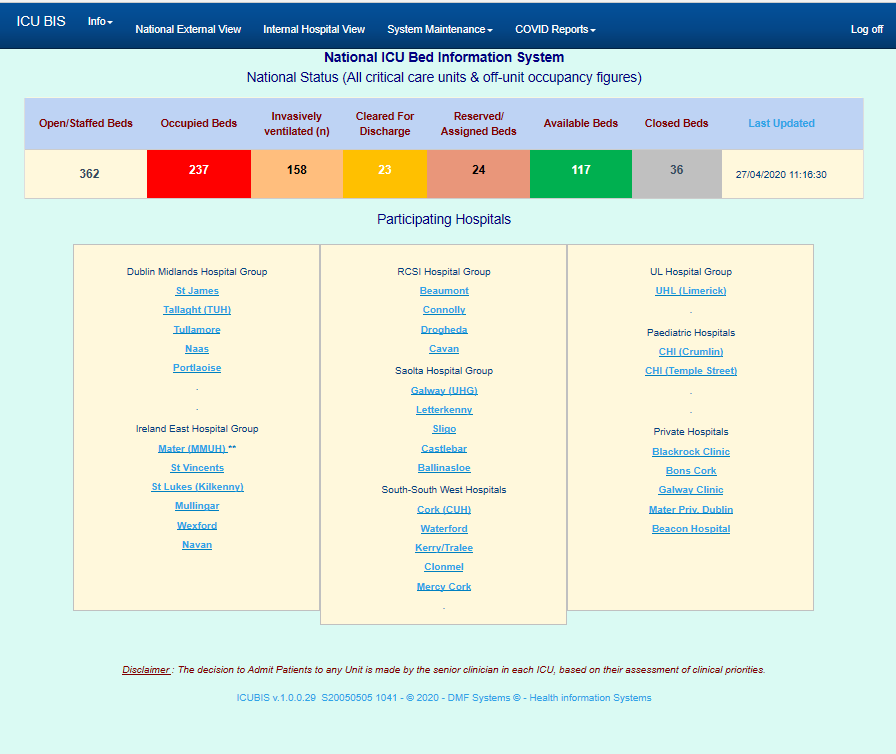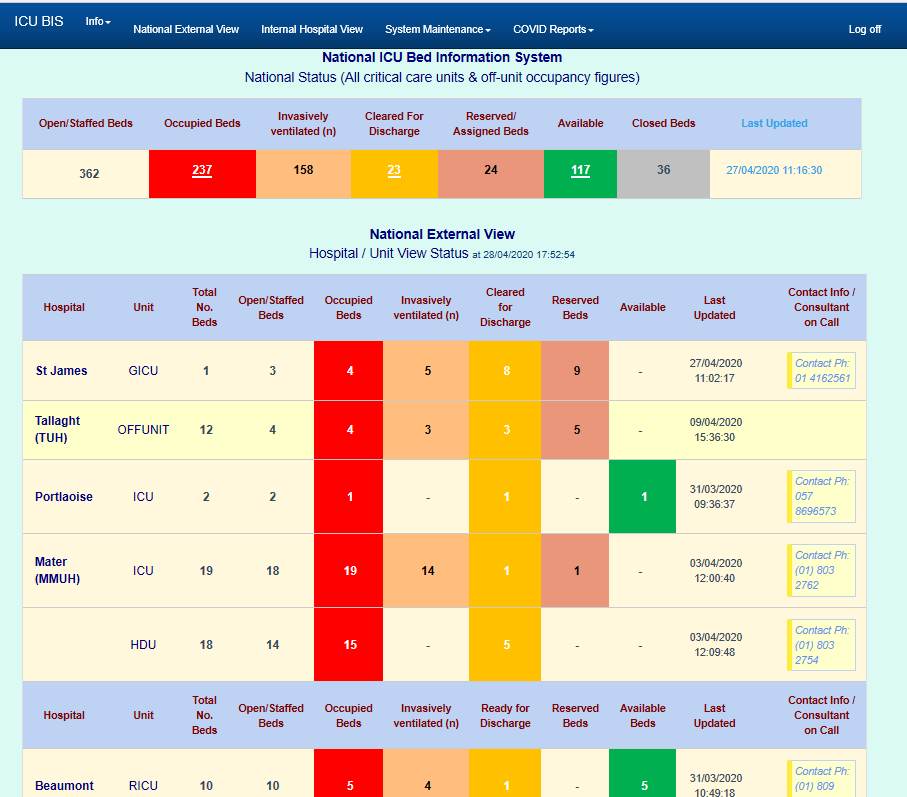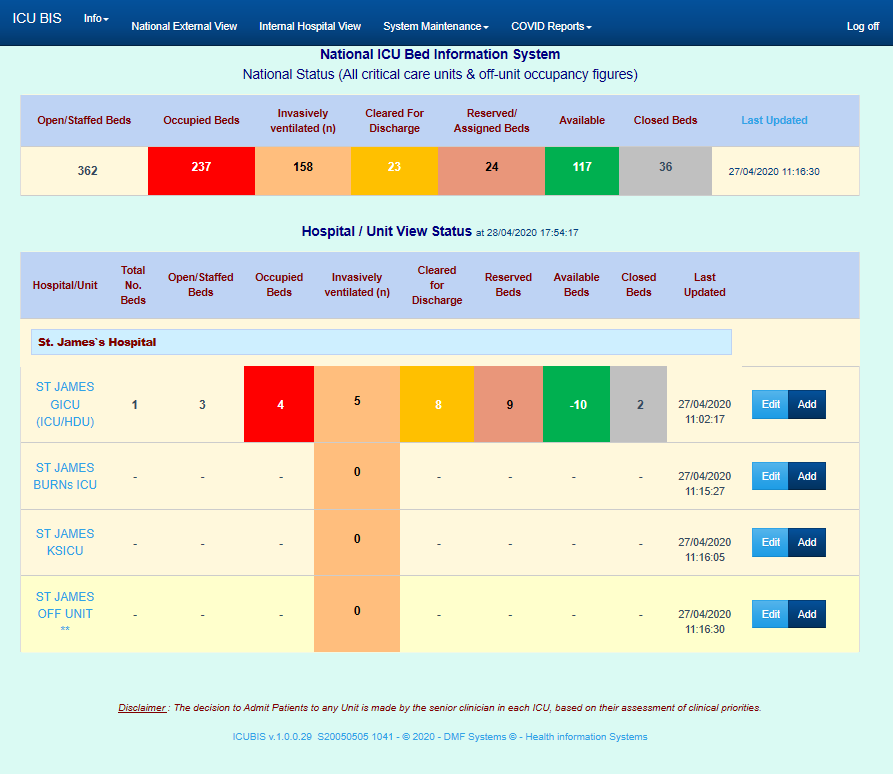Critical ICU Bed Information System Developed & Implemented Nationwide During COVID-19
Last month, we published a LinkedIn post to provide an update on the ICU Bed Information System developed by DMF Systems which went live across the country on the 26th of March, less than one month after Ireland received its first case of the deadly pandemic. The go-live date represented a significant first for Ireland as it was the first time that a live view of ICU Bed Occupancy across the entire country was available to the HSE and Department of Health management teams, as well as to many key critical care practitioners.
The LinkedIn post has since been viewed an incredible amount of times without any paid promotion which has encouraged us to draft a blog about this very topic.
We are absolutely delighted with the engagement and the very many positive replies we received on our post including-
“Congratulations to Declan and all at DMF Systems. This adds an important digital capability on the HSE Digital Transformation journey”
Martin Curley
Director, Digital Transformation and Open Innovation at Health Service Executive.
“It’s excellent to have a live database and very user friendly, Congrats”
Majella Brawders
Assistant Director of Nursing, South Tipperary General Hospital

DMF Systems work with NOCA to Create a Real-time ICU Hospital Bed Occupancy System
We’re grateful for the commitment from everyone on the DMF team as well as our project partners at National Office of Clinical Audit (NOCA), that worked hard to ensure this project was successfully delivered in such a timely manner despite the uncertainty and general flux that arrived when COVID reared its ugly head. Furthermore the response we received is also an acknowledgment of the usefulness of the solution in addressing a vital need within our health system.
So, what is the ICU Bed Information System?
When it comes to Healthcare Technology, What exactly is an ICU Bed Information System
While healthcare management, practitioners and providers were busy planning for an expected surge in ICU cases brought on by the pandemic, it became clear that there was a pressing need for a national ICU Bed Information system. In fact, the project had already been in development for a couple of years and the need for hospital bed management solution that could seamlessly deliver hospital bed occupancy statistics was not a new concept. The National Office of Clinical Audit (NOCA) in their Irish National ICU Audit (INICUA) Annual Report in 2017 noted that mean Bed Occupancy was very high at 91% -far in excess of the standard recommendations made in the report of between 70% and 80%.
In their report NOCA recommended that the HSE should take measures to facilitate the transfer of critically ill patients between hospitals in order to make the optimum use of scarce critical care beds to positively impact hospital bed occupancy nationally. They also suggested that the INICUA database could provide much of the data to support such a system. DMF Systems had been partnering with NOCA since 2014 for the delivery of the INICUA to 24 hospitals across Ireland through the development and implementation of the InfoFlex solution.
With funding provided by the HSE, a project to implement the ICU BIS to record and communicate hospital bed occupancy in intensive care units across Ireland was launched within the scope of the NOCA National ICU Audit project. DMF Systems were tasked with developing and delivering the healthcare technology solution.
The Urgent Need for a Nationwide ICU Hospital Bed Management System
As of February 2020, a live view of ICU hospital bed occupancy for all hospitals across the capital city; Dublin, was available. HSE and Department of Health planning was also underway for the escalating pandemic emergency. With an expected surge in ICU admissions, the urgent need for a national healthcare technology system that could provide up-to-date information on ICU hospital bed occupancy was brought to the forefront. Simultaneously, plans were also set in train to expand the total number of available national ICU beds, including a number of private hospital ICU beds that were brought into the public system to help manage the anticipated surge.
As of writing this article, there are now 33 hospitals live on ICU BIS, hospital bed occupancy solution, which encompasses 77 critical care units (Public Hospitals, Private Hospitals and Paediatric Hospitals) throughout Ireland. The expanded scope of the project and reduced timeframe meant that huge sacrifices were undertaken by the development and implementation team at both DMF Systems and NOCA.
How Does the ICU BIS Provide ICU Hospital Bed Occupancy Information?
The ICU Bed Information System supports both a National view and an Internal hospital view of the ICU bed occupancy status. Typically, the national information is available to all ICU hospital bed management system users, while the hospital view is available to all system users within an individual hospital.
The National view provides the HSE and Hospital intensivists with a live information dashboard detailing the breakdown of Critical Care beds. This includes the number of:
- Open/ staffed beds
- Occupied beds
- Reserved beds
- Beds cleared for discharge
- Unoccupied beds
The dashboard also provides the time of the most recent update to the system for each Critical Care unit using the ICU BIS hospital bed occupancy solution. Real time contact information for the Consultant on call in each Critical Care unit is also directly accessible from the dashboard.

The internal hospital view provides a breakdown of Clinical and Patient information for each of its critical care units and ICU beds. This view provides details including the total number of:
- Beds
- Open/staffed beds
- Occupied beds
- Patients receiving invasive ventilation
- Patients cleared for discharge
- Available beds in each critical care unit within the hospital
The number of available beds in each critical care unit is also summarised and presented nationally.

What Benefits Does the ICU Bed Information System Deliver?
Informed Decision-making
Given that the ICU Bed Information System provides a real-time National overview of ICU hospital bed occupancy and real-time availability, healthcare providers can quickly make informed decisions to enhance patient care. Hospitals that are nearing full ICU bed capacity can quickly make the appropriate decision to transfer a patient to the most suitable hospital which has more available ICU capacity. This level of fast and informed decision-making was not possible prior to the implementation of the ICU Bed Information System.
Faster Referrals between hospitals
In situations, where a hospital is unable to admit a patient to ICU due to a lack of ICU capacity, they can at a glance consult the national dashboard view provided by the ICU BIS and quickly identify hospitals in the vicinity which have the available ICU bed capacity. The communication process between hospitals is streamlined as the contact information for the Consultant on call in each Hospital Critical Care unit can be accessed directly from the dashboard.
Real- time Analysis & Reporting
Data from the ICU Bed Information System is used to report on the total number of critical care beds available, the total number of open and staffed beds, the total number of occupied critical care beds and the available number of critical care beds. Currently this data is used by the Department of Health to monitor trends in COVID-19 numbers in ICU and ICU bed occupancy and availability and it is used daily to inform operational updates.
Enhanced Patient Care Planning
Trends in ICU numbers can be monitored overtime which facilitates effective planning. During the current Covid-19 pandemic, the availability of ICU beds has been the chokepoint in Health systems across the world. Within Ireland predicted trends around the demand on ICU capacity have been used by modelling experts to inform Government decisions about restrictions on activity, lockdown measures etc.
We hope you have found this article informative and once again, we’d like to thank the team at NOCA for the hard work and commitment to the delivery of a national ICU Bed Information System. Please don’t hesitate to get in touch if you have any questions or would like any further information on this, or any other DMF Systems healthcare technology solution.








